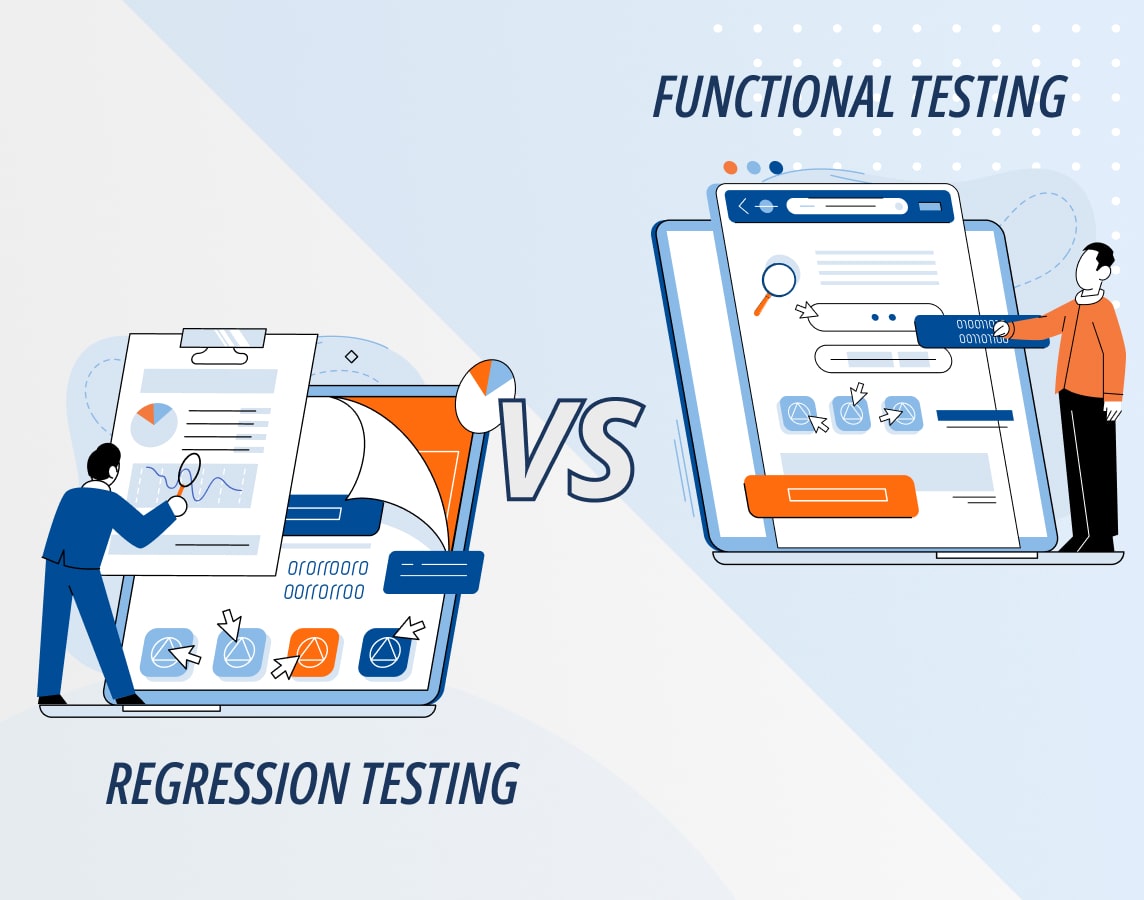In software development, a regression is any change to a system after performing the last test. There are many causes of regressions in software testing, and because of their complexity and impact on the product, you should avoid them where possible.
This article will examine how regression tests differ from functional tests, what each type of testing includes, how these types of tests differ in approach and outcome, an explanation of how to perform them both correctly and incorrectly, and concluding with recommendations on when or whether your team should use one or the other.
What Is Functional Testing?
Functional testing is the traditional software testing that’s been around for a long time. It’s done by running applications in emulation environments or simulating user interactions with your software. It was initially developed to test applications before release. Therefore, it wasn’t necessary to ensure that they had been thoroughly tested.
In modern times, developers perform functional testing to ensure that an application’s functioning is correct, and it’s still considered essential for the quality of an application. It’s also known as user acceptance, built-in testing, or simply unit testing. It tests the application to ensure it has the right functionality and asks no questions about how well it performs under different scenarios.
When you do functional testing, you see if the application you created behaves how you want it to or not. You perform functional testing by using automated tools or through manual testing. A test developer will write their tests, or they can work with a test automation framework.
Functional testing aims to put the functionality into the software under various conditions and scenarios and see how the application reacts. We often combine functional testing with other types of testing, such as unit testing, integration testing, and acceptance testing.
What Is Regression Testing?
We typically run regression tests similarly to functional tests, with emulated environments and real-world interactions. It’s mainly used to ensure that changes or fixes made in an application don’t cause any bugs. We do this by running automated tests against previous versions of the application. Then we compare the output with that of a new version. The main difference between regression and functional testing is that testers look for “failures” more than they verify that the application is working correctly.
Regression testing is where testers look for errors in an application caused by new features and changes to the codebase. It aims to ensure that an application works correctly and does not fail due to code changes. This is because it’s a valuable tool for applications that we have developed to do something different after we have made a new change. This could cause problems for the previous state of the application and any subsequent changes.
Expand Your Test Coverage
Regression Testing Vs. Functional Testing: What’s the Difference?
Regression testers focus on regression testing, looking for errors introduced when developers change an application code. This can include bugs in a new feature or bug fixes.
Functional testers focus on functional testing, checking that the bug-free working version of the application is doing what they designed it to do and will continue to work correctly.
Functional tests focus on individual features, while regression testing focuses on the software’s overall functionality.
We perform functional testing first to ensure that the basic features of the software work appropriately. Regression testing is usually done after functional testing to ensure that changes have not introduced new bugs.
Regression testing is often done automatically, while functional testing is usually done manually.
Functional testing is more concerned with the specific inputs and outputs of a particular function, while regression testing is more concerned with the overall behavior of the software. Functional testing is focused on verifying the software’s functionality, while regression testing is focused on verifying the stability of the software.
The main difference between regression and functional testing is that functional tests focus on whether the interface or function behaves as expected. In contrast, regression tests focus on whether new functions break old functions. While we can do both types of testing within the same software development life cycle, they have different focuses and don’t always occur together.
How to Perform Functional Testing
We use functional and other tests to ensure that the software performs as expected. The purpose is to test an application in a controlled environment to ensure the product works that way out of the box. Functional testing looks for bugs, defects, and other problems. This testing aims to confirm performance, verify usability, and verify that components function as expected with no modification or customization.
Functional testing does not test whether a feature works correctly but whether it works correctly under specific conditions (e.g., what happens if we run our product on a date outside of our regular release cycle?).
It’s important to remember that functional testing is only one piece of the overall testing puzzle. You should perform functional testing with a user-acceptance or business-acceptance test, thus ensuring your product works exactly as you want it to in its intended environment.
Performing a functional test is usually manual, especially with larger applications. The team will begin by evaluating the product and identifying use cases and user stories. Then they’ll construct specific test cases based on the expected results during normal usage. After creating these tests, testers will run them in an isolated environment to identify bugs and issues that may exist within the application itself.
How to Perform Regression Testing
Regression testing ensures that a product’s final release functions as expected in the production environment. Regression testing verifies that new features or changes do not impact old functionality.
A regression test typically verifies that an application’s new features and modifications are compatible with the previous versions during testing. These tests look for problems with new software that was not previously tested during its creation. The tests can also verify that modifications made by other teams or projects do not cause problems.
Regression testing focuses on the new functionality during the testing process. Regression tests run against a predefined set of tests that ensure new code didn’t cause problems with previous versions. When running regression tests, you’ll want results as quickly as possible. The results can be extremely important in identifying problems with your new code before release. You can also perform regression testing by running a test case against systems before releasing or uploading to a live environment because it verifies that your product functions as intended once it’s in production.
Conclusion
Functional testing is a great way to get a quick initial assessment of the application once you’ve created it. However, regression testing is crucial when changing your code because it will help identify any potential stumbling blocks created by new functionality or changes.
You can use the Testim framework to your advantage now that you understand the difference between functional tests and regression tests. Testim automates functional and regression testing, allowing you to focus on designing the next version of your software. It uses a variety of test cases to test your accuracy, including unit tests, integration tests, and end-to-end testing. Using Testim, you can drastically reduce debugging time while improving the quality of your product.



